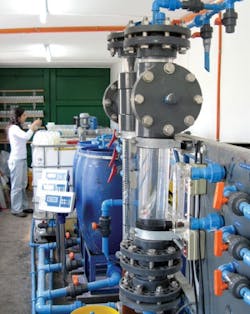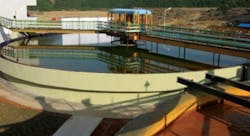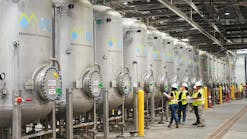| Extacting value: the sulfide precipitation process applied at the Jiangxi Copper Mine in China - recovered copper generates revenue that pays for the cost of water treatment |
An alternative to traditional membrane (or reverse osmosis systems) has emerged in ion exchange for sulfate removal.
The ion exchange processes can be used to remove sulfate salts from waste water streams in a number of industrial applications. Not only does this process dramatically improve recycling rates for water, it also reduces energy consumption and reduces residual waste from water treatment.
When applied to sulfate reduction, ion exchange processes produce clean water that can be reused and solid gypsum which can be used as an input into fertilizers and building products. Residual wastes are eliminated.
The ion exchange process is a two-stage process that employs two different resins to achieve demineralization of the feed by removing calcium and sulfate ions from water. The resins are regenerated using low-cost reagents (sulfuric acid and lime), which contributes to low operating costs.
Wastewater is first passed through a series of contactors containing cation exchange resin to remove calcium and magnesium. It is then passed through anion contactors which remove sulfates. As the ion exchange resins have finite capacities to remove ions from feed water, they periodically undergo regeneration. Sulfuric acid and lime are used to regenerate cation resin and anion resin, respectively.
This ion exchange process has been piloted extensively in the U.S., Canada and Chile and the first commercial scale demonstration plant is scheduled for construction later this year with a large U.S. mining firm.
The pilot operations have demonstrated promising results. Where traditional methods could waste as much as 50% of the water, ion exchange can achieve recovery rates that exceed 95%, reducing industrial dependence on local water reserves.
The process also consumes up to 90% less energy than evaporation and crystallization systems and can therefore generate operating cost savings in some industrial applications. Water discharged after the ion exchange process meets strict regulatory requirements for sulfate concentrations, which can be as low as 100 parts per million (ppm) in some jurisdictions.
Metal recovery: a win-win
Sulfide precipitation is an innovative process that is now being used in a number of mines around the world to combat the effects of acid mine drainage, increase water for reuse and simultaneously generate revenue. Sulfide precipitation selectively removes dissolved metals from waste streams to create clean water and metal by-products that can then be recycled or sold to offset the costs of water treatment.
Developed as an alternative to lime treatment, sulfide precipitation does not result in toxic metal "sludge" as a by-product; saleable metals such as copper, nickel, zinc, and cobalt are instead produced.
Metal-laden water is fed to a contactor tank where sulfide reagents are introduced. The water chemistry conditions in the tank are adjusted to precipitate individual metals as pure metal sulfides. Precipitated metals and treated water are then pumped into a clarifier where they are separated and discharged or recycled.
Jiangxi Copper Company, China's largest copper producer, commissioned (in partnership with BioteQ Environmental Technologies) its first sulfate precipitation treatment site at its Dexing mine in 2008, and last year recovered 1.7 million pounds (771 tonnes approx.) of copper during treatment—enough copper to circumnavigate the globe with household-grade wire.
The sulfide precipitation process has enabled Jiangxi Copper to turn water treatment from a cost center that is an environmental and regulatory necessity into a revenue generator.
This spring, Jiangxi Copper and BioteQ began design work for a second plant at Dexing, using a newly developed ion exchange process to recover cobalt and nickel from mine wastewater. The plant, which will have a design capacity of 800 cubic meters per hour, has an estimated capital cost of $3 million, and will provide new capacity for wastewater treatment at the site. The water to be treated contains very low concentrations of dissolved cobalt and nickel, in the range of four to eight ppm for each metal.
The ion exchange process will concentrate the dissolved metals, which will then be selectively recovered from the water to produce a saleable cobalt-nickel product that will be refined into useful products. Construction is expected to be complete by the end of the year, with commissioning slated for early 2011.
By recovering valuable metals from wastewater, the water treatment plants provide a means to remove metal contaminants from the site, maximise resource recovery, produce treated water that meets strict environmental requirements and reduce the life cycle cost of wastewater treatment at the mine site.
We must continue to find solutions to reduce consumption and increase reuse of water. It is true that regulations are driving change, but social responsibility and sustainable business practices are indeed also part of the picture.
The good news is that commercially viable, energy-efficient and environmentally effective solutions exist and continue to be developed to meet these challenges head on.
Author's note:David Kratochvil is the president and chief operating officer of BioteQ Environmental Technologies. More information can be found at: www.bioteqwater.com.
More Water & WasteWater International Current Issue Articles
More Water & WasteWater International Archives Issue Articles




